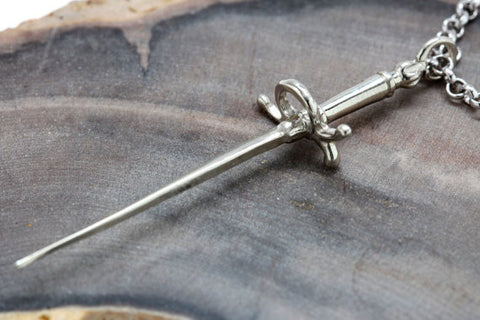This is a replica of a small light rapier sword. It was hand carved and cast in NYC. This piece is either cast in white bronze (sterling silver & bronze) or solid sterling. It comes on an open link rolo chain in your choice of lengths.
Specs : the sword is 2.2 inches long (57 mm) by .66 inches wide at the guard (16.7 mm)
Someone here suggested that it's a blade you could pick your teeth with. Even the highborn pick their teeth, don't they?
Check out my other swords!
History
The rapier began to develop around 1500 as the Spanish espada ropera, or "dress sword". The espada ropera was a cut-and-thrust civilian weapon for self-defense and the duel, while earlier weapons were equally at home on the battlefield. Its development began at a time period when the need for a lighter and faster sword became mandatory thanks to the introduction of firearm use in warfare and the corresponding de-emphasis on heavy armor. Throughout the 16th century, a variety of new, single-handed civilian weapons were being developed, including the German Rapier, another cut-and-thrust weapon used for sportive fencing, as described in Joachim Meyer's, Fechtbuch of 1570. 1570 is also the year in which the Italian swordmaster, Signior Rocco Bonetti, first settled in England advocating the use of the rapier for thrusting as opposed to cutting or slashing when engaged in a duel. Nevertheless, the English word "rapier" generally refers to a primarily thrusting weapon, developed by the year 1600 as a result of the geometrical theories of such masters as Camillo Agrippa, Ridolfo Capoferro and Vincentio Saviolo.
The rapier became extremely fashionable throughout Europe with the wealthier classes, but was not without its detractors. Some people, such as George Silver, disapproved of its technical potential and the dueling use to which it was put.
The etymology of the word rapier is uncertain. Charles du Fresne, sieur du Cange, in his Glossarium mediae et infimae Latinitatis, cites a form Rapperia in from a Latin text from 1511. He mentions an etymology deriving the word from the Greek ραπίζειν "to strike." However, Walter William Skeat suggested that "rapiér" may derive from raspiére, a poker, and that this may be a contemptuous term developed by older cut-and-thrust fencers for the new weapon. The most probable root of this term, however, appear to be from the Spanish ropera that comes from ropa, or elegant dress, thus a "dress sword".











